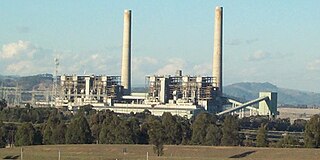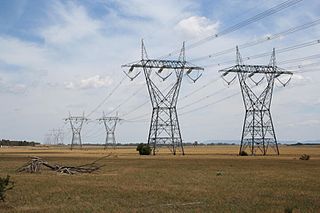
The Loy Yang Power Station is a brown coal- fired thermal power station located on the outskirts of the city of Traralgon, in south-eastern Victoria, Australia. It consists of two sections, known as Loy Yang A and Loy Yang B. Both Loy Yang A and B are supplied by the Loy Yang brown coal mine. The Loy Yang power stations are located in the brown coal rich Latrobe Valley, along with the Yallourn power station.
Alinta was an Australian energy infrastructure company. It has grown from a small, Western Australia-based gas distributor and retailer to the largest energy infrastructure company in Australia. It was bought in 2007 by a consortium including Singapore Power and various parties which include the now defunct Babcock & Brown funds.

Liddell Power Station is a coal-fired thermal power station with four 500 megawatts (670,000 hp) GEC steam driven turbine alternators for a combined electrical capacity of 2,000 megawatts (2,700,000 hp).
Redbank Power Station is a biomass power station located in Warkworth, within the Hunter Region of New South Wales, Australia. The station is currently awaiting a restart of operations after converting from its original use as a coal-fired power station. Redbank is unique for its utilisation of circulating fluidised bed technology, the only generator of its kind in Australia. Upon re-fire, the station will operate using 100% biomass at a capacity of 151MW of electricity.

Torrens Island Power Station is located on Torrens Island, near Adelaide, South Australia and is operated by AGL Energy. It burns natural gas in eight steam turbines to generate up to 1,280 MW of electricity. The gas is supplied via the SEAGas pipeline from Victoria, and the Moomba Adelaide Pipeline System (MAPS) from Moomba in the Cooper Basin. The station is capable of burning either natural gas or fuel oil. It is the largest power station in South Australia and was formerly the largest single power station user of natural gas in Australia.
Northern Power Station was located at Port Paterson in the Australian state of South Australia about 6 kilometres (3.7 mi) south of the city centre of Port Augusta. It was coal powered with two 260 MW steam turbines that generated a total of 520 MW of electricity. It was operated and maintained by Alinta Energy and was commissioned in 1985. Northern received coal by rail from the Leigh Creek Coal Mine, 280 km to the north. The plant ceased electricity production in May 2016 and decommissioned and demolished over the following few years.
Playford B Power Station was located at Port Paterson in the Australian state of South Australia about 5.5 kilometres (3.4 mi) south of the city centre of Port Augusta. It was coal powered with four 60 MW steam turbines that generated a total of 240 MW of electricity. Playford B received coal by rail from the Leigh Creek Coal Mine, 280 km to the north and drew cooling water from Spencer Gulf, returning it to the sea at an elevated temperature. Commissioned in 1963, it was co-located with the older Playford A Power Station and the larger, newer Northern Power Station. Playford B was mothballed in 2012 and its permanent closure was announced by operator Alinta Energy in October 2015. Prior to being mothballed, it primarily operated in the summer, when electricity demand peaks.

AGL Energy Ltd is an Australian listed public company involved in both the generation and retailing of electricity and gas for residential and commercial use. AGL is Australia's largest electricity generator, and the nation's largest carbon emitter. In 2014, the company had an operated generation capacity of 10,984 MW. The company emitted 42,227,180 Total Scope 1 Emissions in 2019-20 and 40,209,034 t CO2-e in 2020–21. AGL is also a significant investor, owner, and operator, of renewable energy assets.

The Newport Power Station was a complex of power stations located on the west bank of the Yarra River, approximately 6 km south-west of Melbourne, Victoria, Australia, in the suburb of Newport. Newport A, B, and C were coal-fired plants which operated at the site between 1919 and the 1980s, and were claimed to be the largest power station in the southern hemisphere in 1953 with 42 boilers and 14 turbo-alternators producing 327 megawatts (439,000 hp).

Energy in Victoria, Australia is generated using a number of fuels or technologies, including coal, natural gas and renewable energy sources. Brown coal, historically, was the main primary energy source for the generation of electricity in the state, accounting for about 85% of electricity generation in 2008. The amount of coal-fired power has decreased significantly with the closure in 2017 of the Hazelwood power station which supplied around 20% of Victoria's electricity, and to a lesser extent with the exit of Anglesea power station in 2015. Brown coal is one of the largest contributors to Australia's total domestic greenhouse gas emissions and a source of controversy for the country. Australia is one of the highest polluters of greenhouse gas per capita in the world.
Telford Cut was an open-cut coal mine, now closed, in the Leigh Creek Coalfield in South Australia. For the 72 years between its opening in 1943 and its closure, the mine supplied sub-bituminous coal to fire power stations first in Adelaide then, from 1954, Port Augusta. Production ceased in November 2015 but stockpiled product was transported to Port Augusta until the last power station closed down in May 2016.

Reeves Plains is a settlement in South Australia. It is on the Adelaide Plains, halfway from Gawler to Mallala.

Coal phase-out is an environmental policy intended to stop using the combustion of coal in coal-burning power plants, and is part of fossil fuel phase-out. Coal is the most carbon-intensive fossil fuel, therefore phasing it out is critical to limiting climate change and keeping global warming to 1.5 °C as laid out in the Paris Climate Agreement. The International Energy Agency (IEA) estimates that coal is responsible for over 30% of the global average temperature increase above pre-industrial levels.
South Australia is a leader in utility-scale renewable energy generation, and also produces gas and uranium for electricity generation. Gas production is mostly concentrated in the Cooper Basin in the state's north-east. Gas is delivered from these fields by pipeline to users interstate and to Port Adelaide where it fuels three separate gas-fired power plants. Uranium is also mined in South Australia, though nuclear power generation is prohibited nationally. The Olympic Dam mine is the world's single largest known deposit of uranium and represents 30% of the world's total uranium resource. Many utility-scale wind farms and solar farms have been commissioned during the 21st century and geology with potential for geothermal energy has also been identified but is yet to be developed.

Alinta Energy is an Australian electricity generating and gas retailing private company owned by Hong Kong–based Chow Tai Fook Enterprises (CTFE). It was sold for $4 billion and was approved Treasurer Scott Morrison in 2017. Alinta Energy has an owned and contracted generation portfolio of up to 1,957 MW, approximately 1.1 million combined electricity and gas retail customers and around 800 employees across Australia and New Zealand.
The Moomba Adelaide Pipeline System is a natural gas pipeline delivering gas from the Cooper Basin gas wells near Moomba to Adelaide, with spur pipelines to Angaston and Whyalla. It can also receive gas from Southeastern Queensland through the QSN Link pipeline owned by APA Group.

Playford A power station was the first power station built by the Electricity Trust of South Australia at Port Paterson, South Australia near Port Augusta in South Australia. It was built in 1954 to generate electricity from coal mined from the Telford Cut at Leigh Creek and transported 250 kilometres (160 mi) by rail.











